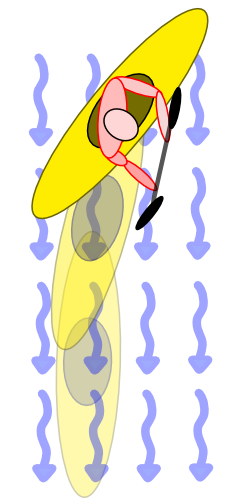
The rudder is the most efficient stroke to control the direction and keeping speed during a curve. This stroke prevents the kayak to move side wise and thus to loose energy.
How to do it
To execute the rudder you have to turn your torso towards the inside of the curve. In this way your shaft should be parallel both to your shoulder axis and to the boat and at 45° with the water surface. The blade has to face the stern like in figure. For maximum efficiency the blade has to be deeply immersed and it has to work as a fin with a vertical surface.
We can call "stern rudder" when we have the blade in the back area. Otherwise when we verticalize the shaft and we have the blade facing your body, we can call it "central rudder". The stroke is static and you have to keep the position modifying slightly the angle between the kayak and the paddle or moving the blade from the stern to the center to control the boat curve.
Exercises to learn it
To make a rudder in flat water you have to begin with straight speed and suddenly leave the kayak slightly turning to one side. The goal is to draw a semicircular line using only the rudder. The rudder stroke can help you control the direction and avoid to loose speed as normally happens if you leave the kayak turning without any stroke in the water.
The stern rudder tend to stop the rotation while the central rudder let the kayak rotate a bit more. The stern rudder can be really useful in catching eddies and get into the current to control the boat direction.


